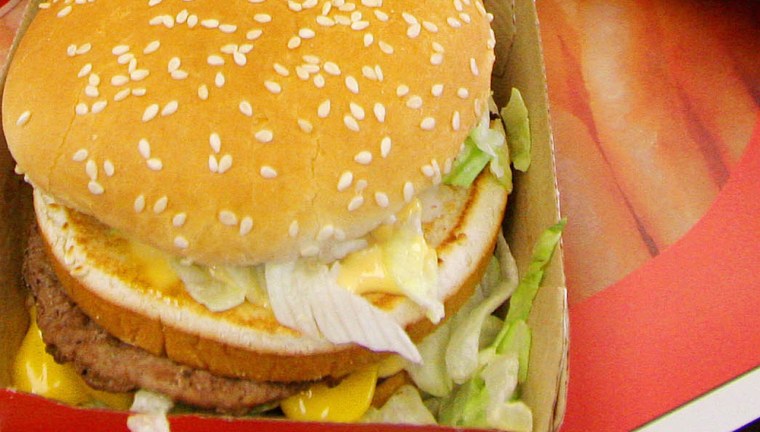In his 2001 best-seller "Fast Food Nation," author Eric Schlosser is out to kill our appetite for fast foods like the Big Mac and its $1 cousin, the Whopper Jr. He admits they taste great, but he argues that such meals are filled with chemicals that could make cardboard smell delicious, while the actual food often contains microbes spread by fecal material. He's spinning his argument forward these days with a movie adaptation of "Fast Food Nation" and a new kid's version of the book, "Chew on This."
But what would happen if Americans did become healthier-minded and stopped ordering off the McDonald's Dollar Menu? What if a drop in demand trickled down through the economy? What would happen if factory farms and meatpacking plants cleaned up their acts, or if fast food chains reformulated their offerings with fresher ingredients and compensated their teenage workers with higher wages and benefits? How much would it really cost to eat the Schlosser way?
Let's be clear. There are few, if any, signs that such changes are on the horizon. In fact, last week, the National Restaurant Association, the National Council of Chain Restaurants and 16 other food-industry lobby groups launched BestFoodNation.com, a Web site created specifically to counter Schlosser's books and his movie, which debuted Friday at the Cannes Film Festival.
The site quotes employees from Tyson Foods, Cargill and other food producers who insist that the nation's food safety and its prices are fine just the way they are. Several members of the group refused to discuss the potential price effects Schlosser's recommendations would have. The National Council of Chain Restaurants also declined to comment.
As for McDonald's, we asked them if the price of a Big Mac would double. "If Eric Schlosser is looking for high-quality food, outstanding safety records and great value, McDonald's already delivers that. Beyond that, we can't speculate about his book," said a company spokeswoman.
Thomas Dobbs, an agricultural economics professor at South Dakota State University, says it's impossible to know exactly how much healthier food would cost us, but he estimated it would be, at most, 25 percent more expensive than what we eat now, if everyone were eating it.
Finding hard numbers isn't easy. The price of food is the result of a complicated formula that involves seasonal weather fluctuations, transportation costs and other factors.
Government subsidies also heavily factor into the equation. The corn industry, for example, received $10 billion in subsidies from fiscal 2003 through last year. Corn is used to feed millions of cattle, and it's also turned into cheap high-fructose corn syrup, which sweetens everything from Coke to pasta sauces to crackers.
So should we all be eating out of the organic aisle of the supermarket? While Schlosser doesn't advocate organic foods, which are grown without synthetic pesticides or chemical fertilizers, they do approximate the kind of low-processed foods he seems to be a fan of.
Unfortunately, organic food is typically more expensive than industrialized food, usually costing 25 percent to 100 percent as much. That may explain why Whole Foods Market, which has capitalized on the public's interest in more natural foods, has been nicknamed "Whole Paycheck" for its high prices. An example: Last week in downtown Chicago, a dozen large regular eggs cost $1.79, while a dozen large organic, cage-free eggs sold for $3.39.
Why are processed foods so much cheaper? The wholesale cost of industrialized foods — from meat to milk — is less expensive. Again, government subsidies help, but processing has become so standardized that foods are cheaper to produce using established factory processes. According to Harwood Schaffer, a research associate at the University of Tennessee's Agricultural Policy Analysis Center, a loaf of bread has gotten so cheap that "the wrapper costs more than the wheat that goes inside."
Got (organic) milk?
Right now, the demand for organic milk exceeds supply, and that's driving prices higher. Also, costs for producers like Organic Valley, the nation's largest organic dairy cooperative, are still higher than their traditional counterparts. The co-op says that they and some of their members spend 10 percent more to produce milk organically versus conventionally, and by the time it reaches supermarkets, a gallon of organic milk is 42 percent more expensive than conventional milk, according to Spins, a research firm that tracks the natural foods industry.
Mike Callicrate, owner of Ranch Foods Direct, says that to produce an animal without steroids, hormones or antibiotics, he spends 8 percent more than he figures he would spend otherwise. Last week in Colorado Springs, Colo., 90 percent lean commodity beef was priced at $4.29, while Callicrate's equivalent was selling for $5.19.
But although the price of a meal from a fast food restaurant may seem cheap at the counter, it has other hidden costs, says Schlosser. "The dollar menu at fast food chains doesn't include the cost of dialysis you'll need after eating such foods on a regular basis, and it doesn't include the costs of treating diseases caused by obesity," he says. Ultimately, he says, the food industry in general and fast food chains in particular are "imposing all kinds of costs on society." According to Schlosser, "We're already paying too much."
